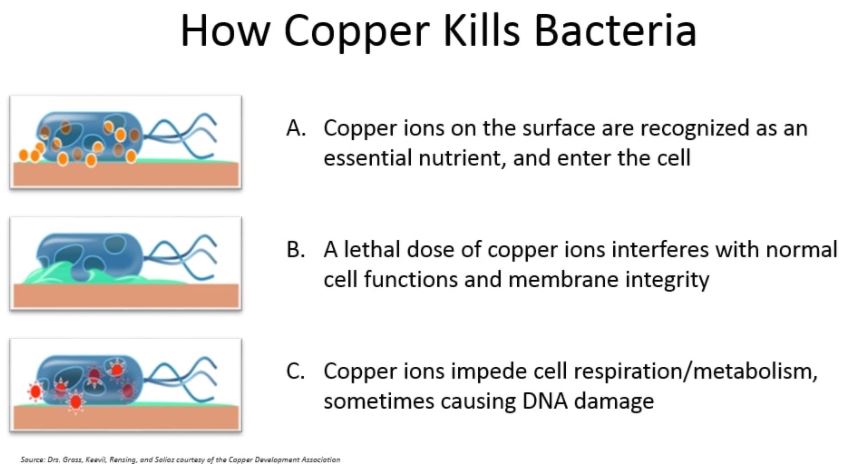How Copper Kills Bacteria
Copper continuously oxidizes and produces ions that break down the cell walls of bacteria. Bacteria attempt to adapt to their environment by taking in elements from their surroundings. As a result, the bacteria absorb the copper ions, and they flood into the cell. Copper is toxic to the inside of the cell—once inside the membrane, the ions damage the cell’s DNA.

How Does Copper Effect Bacteria
Every cell’s outer membrane, including that of a single-cell organism like a bacterium, is characterized by a stable electrical micro-current. This is often called “transmembrane potential” and is literally a voltage difference between the inside and the outside of a cell. It is strongly suspected that when a bacterium comes into contact with a copper surface, this can short-circuit the current in the cell membrane. This weakens the membrane and creates holes. Another way to make a hole in a membrane is via localized oxidation. This happens when a single copper molecule, or copper ion, is released from the copper surface and hits a building block of the cell membrane (either a protein or a fatty acid). If the “hit” occurs in the presence of oxygen, we speak of oxidative damage.
What Happens to the Cell after the Membrane Is Damaged?
Now that the cell’s outer membrane has been damaged, there is a steady stream of copper ions entering the cell. Copper ions quickly overwhelm the inside of the cell and obstruct its metabolism. A cell’s metabolic reactions are accomplished and catalyzed by enzymes. When excess copper binds to these enzymes, their activity shuts the cell down. The bacteria can no longer breathe, eat, digest, or create energy.
CuVerro® bactericidal copper alloys are the first solid surface registered by the EPA to kill 99.9% of bacteria* like MRSA when cleaned regularly. Its efficacy is tested and proven, which makes CuVerro the ideal alternative to traditional materials for any environment.
EPA-registered, CuVerro surfaces kill pathogens responsible for causing healthcare-associated infections (HAIs):
Staphylococcus aureus
Methicillin-Resistant Staphylococcus aureus (MRSA)
Vancomycin-Resistant Enterococcus faecalis (VRE)
E. coli O157:H7
Pseudomonas aeruginosa
Enterobacter aerogenes
*Laboratory testing shows that, when cleaned regularly, CuVerro surfaces kill greater than 99.9% of the following bacteria within 2 hours of exposure: Methicillin-Resistant Staphylococcus aureus, Staphylococcus aureus, Enterobacter aerogenes, Pseudomonas aeruginosa, E. coli O157:H7, and Vancomycin-Resistant Enterococcus faecalis (VRE).
** Information and image sourced in partnership with CuVerro.